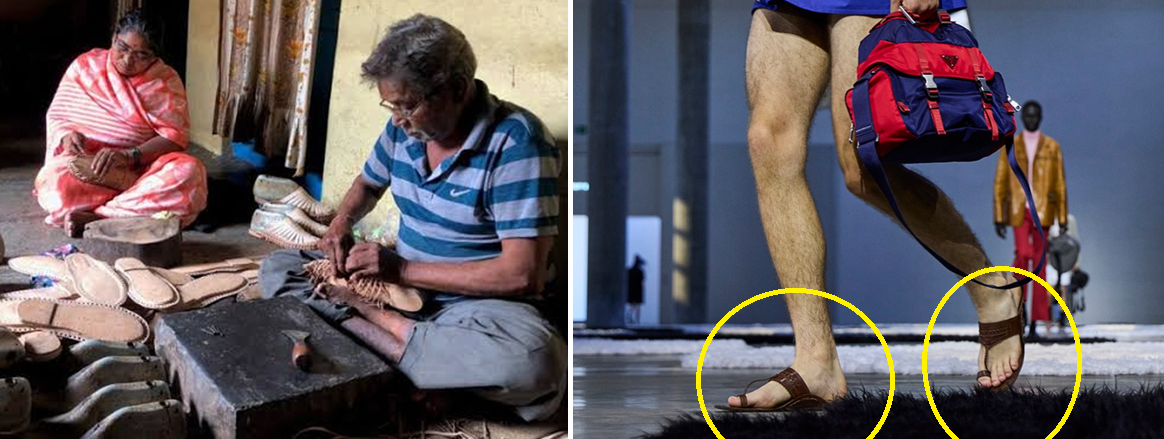
Prada’s SS26 menswear show in Milan featured sandals strikingly similar to India’s iconic Kolhapuri chappals, without crediting their origin
From Kolhapur to the Catwalk: A Design Without a Name
Heritage Hijacked- At the heart of Milan Fashion Week 2026, Prada’s Spring/Summer menswear collection dazzled with its minimalist silhouettes and earthy tones. But amid the applause, a quiet storm was brewing. Fashion enthusiasts across India and the diaspora quickly recognized a familiar design on the runway: flat leather sandals with toe loops and T-straps, unmistakably reminiscent of Kolhapuri chappals, a traditional Indian footwear style with centuries of heritage.
Table of Contents
The sandals, rebranded as “leather flats” and priced at over ₹1 lakh, bore no mention of their Indian origin. No nod to Kolhapur. No credit to the artisans. No cultural context. Just a luxury label and a runway spotlight.
Kolhapuri chappals, handmade by skilled artisans in Maharashtra and Karnataka, are more than just footwear—they are a symbol of resilience, heritage, and craftsmanship. Awarded a Geographical Indication (GI) tag in 2019, these chappals are crafted using vegetable-tanned leather and traditional techniques passed down through generations. Their sudden appearance on a global runway, stripped of identity has left many asking: Is this fashion, or is it theft?
Pride Meets Protest: The Internet Reacts
The backlash was swift and sharp. Indian fashion bloggers, designers, and cultural commentators took to social media to call out Prada’s omission. While some expressed pride in seeing Indian design on a global stage, many others condemned the lack of attribution as a textbook case of cultural appropriation.
“It’s okay to be inspired,” one influencer wrote, “but not okay to erase.” Another user posted side-by-side images of traditional Kolhapuris and Prada’s sandals, captioned: “From ₹800 to ₹1,16,000, minus the credit.”
This isn’t the first time global fashion houses have borrowed from Indian aesthetics without acknowledgment. From dupatta-style scarves rebranded as “Scandinavian wraps” to mirror-work skirts passed off as “boho chic,” the pattern is familiar, and frustrating. The Prada incident has reignited calls for ethical fashion practices, including transparent sourcing, fair compensation, and cultural credit.
Even more troubling is the irony: while Kolhapuris walk the ramp in Milan, the craft is struggling for survival in India. Artisans face declining demand, low wages, and limited access to global markets. For many, the Prada moment feels like a missed opportunity to uplift a dying tradition.
Fashion’s Moral Dilemma: Inspiration vs. Appropriation
The Prada controversy has sparked a broader conversation about the fine line between cultural appreciation and appropriation. In a globalized world, cross-cultural inspiration is inevitable—and often beautiful. But when a design rooted in a specific culture is commercialized without context, it risks becoming exploitative.
Fashion critics argue that luxury brands have a responsibility to acknowledge their sources, especially when drawing from marginalized or underrepresented communities. A simple mention of Kolhapur in the show notes, a collaboration with Indian artisans, or even a public statement could have transformed this moment from controversy to celebration.
Some Indian designers, like Rahul Mishra and Gaurav Gupta, have shown how to blend tradition with innovation while honoring their roots. Their success on global runways proves that authenticity and respect can coexist with creativity.
As for Prada, the brand has yet to issue a statement. But the silence speaks volumes. In an industry that thrives on storytelling, erasing the origin of a centuries-old craft is not just an oversight, it’s a disservice.
Conclusion: Heritage Hijacked
Prada’s Kolhapuri-inspired sandals may have strutted down the runway, but they’ve also walked into a storm. The incident is a stark reminder that fashion without credit is fashion without conscience. As the world celebrates diversity, it must also protect the dignity of the cultures it draws from. Because heritage isn’t a trend, it’s a legacy. And it deserves to be worn with pride, not silence.
Stay updated with the latest news on Rapido Updates. Keep yourself updated with The World, India News, Entertainment, Market, Automobile, Gadgets, Sports, and many more
1 thought on “Heritage Hijacked? Prada’s Kolhapuri-Inspired Sandals Ignite Cultural Appropriation Firestorm”